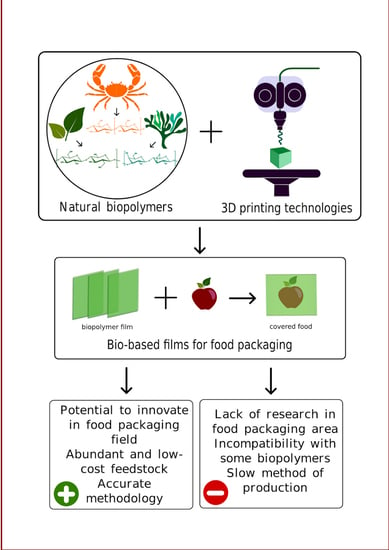Latest Trends in Sustainable Polymeric Food Packaging Films
Abstract
1. Introduction
2. Novel Materials for Food Packaging Films: Biopolymers and Additives
3. Main Methods Used in the Production of Bio-Based Films
4. Three-Dimensional Printing of Food Packaging and Films
4.1. Vat Photopolymerization
4.2. Material Jetting
4.3. Powder Bed Fusion
4.4. Material Extrusion
5. Perspectives on AM in the Production of Bio-Based Films
5.1. Vat Photopolymerization and Material Jetting
5.2. Powder Bed Fusion
5.3. Material Extrusion
6. Limitations of 3D Printing in the Production of Films
7. Conclusions and Future Perspectives
Author Contributions
Funding
Acknowledgments
Conflicts of Interest
References
- Piergiovanni, L.; Limbo, S. Introduction to Food Packaging Materials. In Food Packaging Materials; Springer: Cham, Switzerland, 2016; pp. 1–3. [Google Scholar] [CrossRef]
- Tajeddin, B.; Arabkhedri, M. Polymers and food packaging. In Polymer Science and Innovative Applications; Elsevier: Amsterdam, The Netherlands, 2020; pp. 525–543. [Google Scholar] [CrossRef]
- Geyer, R.; Jambeck, J.R.; Law, K.L. Production, use, and fate of all plastics ever made. Sci. Adv. 2017, 3, e1700782. [Google Scholar] [CrossRef] [PubMed]
- Statista. Annual Production of Plastics Worldwide from 1950 to 2020. Available online: https://www.statista.com/statistics/282732/global-production-of-plastics-since-1950/ (accessed on 24 November 2022).
- Vartiainen, J.; Vähä-Nissi, M.; Harlin, A. Biopolymer Films and Coatings in Packaging Applications—A Review of Recent Developments. Mater. Sci. Appl. 2014, 05, 708–718. [Google Scholar] [CrossRef]
- Varghese, S.A.; Siengchin, S.; Parameswaranpillai, J. Essential oils as antimicrobial agents in biopolymer-based food packaging –A comprehensive review. Food Biosci. 2020, 38, 100785. [Google Scholar] [CrossRef]
- Rodrigues, C.; Souza, V.; Coelhoso, I.; Fernando, A. Bio-Based Sensors for Smart Food Packaging—Current Applications and Future Trends. Sensors 2021, 21, 2148. [Google Scholar] [CrossRef] [PubMed]
- Jabeen, N.; Majid, I.; Nayik, G.A.; Yildiz, F. Bioplastics and food packaging: A review. Cogent Food Agric. 2015, 1, 1117749. [Google Scholar] [CrossRef]
- Jariyasakoolroj, P.; Leelaphiwat, P.; Harnkarnsujarit, N. Advances in research and development of bioplastic for food packaging. J. Sci. Food Agric. 2020, 100, 5032–5045. [Google Scholar] [CrossRef]
- Sullivan, D.J.; Azlin-Hasim, S.; Cruz-Romero, M.; Cummins, E.; Kerry, J.P.; Morris, M.A. Natural Antimicrobial Materials for Use in Food Packaging. In Handbook of Antimicrobial Coatings; Elsevier: Amsterdam, The Netherlands, 2018; pp. 181–233. [Google Scholar] [CrossRef]
- Suppakul, P. Natural extracts in plastic food packaging. In Multifunctional and Nanoreinforced Polymers for Food Packaging; Woodhead Publishing Limited: Cambridge, UK, 2011; pp. 421–459. [Google Scholar] [CrossRef]
- Beoletto, V.; Oliva, M.d.L.M.; Marioli, J.; Carezzano, M.; Demo, M. Antimicrobial Natural Products Against Bacterial Biofilms. In Antibiotic Resistance Mechanisms and New Antimicrobial Approaches; Academic Press: Cambridge, MA, USA, 2016; pp. 291–307. [Google Scholar] [CrossRef]
- Jafri, H.; Ansari, F.A.; Ahmad, I. Prospects of Essential Oils in Controlling Pathogenic Biofilm. In New Look to Phytomedicine: Advancements in Herbal Products as Novel Drug Leads; Elsevier Inc.: Amsterdam, The Netherlands, 2018; pp. 203–236. [Google Scholar] [CrossRef]
- Hu, W.S.; Nam, D.M.; Choi, J.Y.; Kim, J.S.; Koo, O.K. Anti-attachment, anti-biofilm, and antioxidant properties of Brassicaceae extracts on Escherichia coli O157:H7. Food Sci. Biotechnol. 2019, 28, 1881–1890. [Google Scholar] [CrossRef]
- Khumkomgool, A.; Saneluksana, T.; Harnkarnsujarit, N. Active meat packaging from thermoplastic cassava starch containing sappan and cinnamon herbal extracts via LLDPE blown-film extrusion. Food Packag. Shelf Life 2020, 26, 100557. [Google Scholar] [CrossRef]
- Lu, W.; Cui, R.; Zhu, B.; Qin, Y.; Cheng, G.; Li, L.; Yuan, M. Influence of clove essential oil immobilized in mesoporous silica nanoparticles on the functional properties of poly(lactic acid) biocomposite food packaging film. J. Mater. Res. Technol. 2021, 11, 1152–1161. [Google Scholar] [CrossRef]
- Sanches, M.A.R.; Camelo-Silva, C.; Carvalho, C.D.S.; de Mello, J.R.; Barroso, N.G.; Barros, E.L.D.S.; Silva, P.P.; Pertuzatti, P.B. Active packaging with starch, red cabbage extract and sweet whey: Characterization and application in meat. LWT Food Sci. Technol. 2021, 135. [Google Scholar] [CrossRef]
- Severo, C.; Anjos, I.; Souza, V.G.; Canejo, J.P.; Bronze, M.; Fernando, A.L.; Coelhoso, I.; Bettencourt, A.F.; Ribeiro, I.A. Development of cranberry extract films for the enhancement of food packaging antimicrobial properties. Food Packag. Shelf Life 2021, 28, 100646. [Google Scholar] [CrossRef]
- Souza, V.G.L.; Pires, J.R.; Vieira, T.; Coelhoso, I.M.; Duarte, M.P.; Fernando, A.L. Activity of chitosan-montmorillonite bionanocomposites incorporated with rosemary essential oil: From in vitro assays to application in fresh poultry meat. Food Hydrocoll. 2019, 89, 241–252. [Google Scholar] [CrossRef]
- Priyadarshi, R.; Rhim, J.-W. Chitosan-based biodegradable functional films for food packaging applications. Innov. Food Sci. Emerg. Technol. 2020, 62, 102346. [Google Scholar] [CrossRef]
- Kumar, S.; Mukherjee, A.; Dutta, J. Chitosan based nanocomposite films and coatings: Emerging antimicrobial food packaging alternatives. Trends Food Sci. Technol. 2020, 97, 196–209. [Google Scholar] [CrossRef]
- Wang, H.; Qian, J.; Ding, F. Emerging Chitosan-Based Films for Food Packaging Applications. J. Agric. Food Chem. 2018, 66, 395–413. [Google Scholar] [CrossRef]
- da Rocha, M.; de Souza, M.M.; Prentice, C. Biodegradable Films: An Alternative Food Packaging. In Food Packaging and Preservation; Elsevier Inc.: Amsterdam, The Netherlands, 2018; pp. 307–342. [Google Scholar] [CrossRef]
- Menezes, J.; Athmaselvi, K. Report on Edible Films and Coatings. In Food Packaging and Preservation; Elsevier Inc.: Amsterdam, The Netherlands, 2018; pp. 177–212. [Google Scholar] [CrossRef]
- Suhag, R.; Kumar, N.; Petkoska, A.T.; Upadhyay, A. Film formation and deposition methods of edible coating on food products: A review. Food Res. Int. 2020, 136, 109582. [Google Scholar] [CrossRef]
- Taketa, T.B.; Bataglioli, R.A.; Neto, J.B.M.R.; de Carvalho, B.G.; de la Torre, L.G.; Beppu, M.M. Fundamentals and biomedical applications of biopolymer-based layer-by-layer films. In Biopolymer Membranes and Films; Elsevier: Amsterdam, The Netherlands, 2020; pp. 219–242. [Google Scholar] [CrossRef]
- Ashter, S.A. Extrusion of biopoymers. In Introduction to Bioplastics Engineering; Elsevier: Oxford, UK, 2016; pp. 211–225. [Google Scholar]
- McKeen, L.W. Production of Films. In Film Properties of Plastics and Elastomers, 3rd ed.; McKeen, L.W., Ed.; Elsevier: Oxford, UK, 2017; pp. 65–79. [Google Scholar] [CrossRef]
- Liu, Y.; Yuan, Y.; Duan, S.; Li, C.; Hu, B.; Liu, A.; Wu, D.; Cui, H.; Lin, L.; He, J.; et al. Preparation and characterization of chitosan films with three kinds of molecular weight for food packaging. Int. J. Biol. Macromol. 2020, 155, 249–259. [Google Scholar] [CrossRef]
- Xu, Y.; Liu, X.; Jiang, Q.; Yu, D.; Xu, Y.; Wang, B.; Xia, W. Development and properties of bacterial cellulose, curcumin, and chitosan composite biodegradable films for active packaging materials. Carbohydr. Polym. 2021, 260, 117778. [Google Scholar] [CrossRef]
- Ezati, P.; Rhim, J.-W. pH-responsive chitosan-based film incorporated with alizarin for intelligent packaging applications. Food Hydrocoll. 2020, 102, 105629. [Google Scholar] [CrossRef]
- Wilfer, P.B.; Giridaran, G.; Jeevahan, J.J.; Joseph, G.B.; Kumar, G.S.; Thykattuserry, N.J. Effect of starch type on the film properties of native starch based edible films. Mater. Today Proc. 2021, 44, 3903–3907. [Google Scholar] [CrossRef]
- Rajeswari, A.; Christy, E.J.S.; Swathi, E.; Pius, A. Fabrication of improved cellulose acetate-based biodegradable films for food packaging applications. Environ. Chem. Ecotoxicol. 2020, 2, 107–114. [Google Scholar] [CrossRef]
- Nikvarz, N.; Khayati, G.R.; Sharafi, S. Preparation of UV absorbent films using polylactic acid and grape syrup for food packaging application. Mater. Lett. 2020, 276, 128187. [Google Scholar] [CrossRef]
- Wang, L.-F.; Rhim, J.-W. Preparation and application of agar/alginate/collagen ternary blend functional food packaging films. Int. J. Biol. Macromol. 2015, 80, 460–468. [Google Scholar] [CrossRef]
- Hou, X.; Xue, Z.; Xia, Y.; Qin, Y.; Zhang, G.; Liu, H.; Li, K. Effect of SiO2 nanoparticle on the physical and chemical properties of eco-friendly agar/sodium alginate nanocomposite film. Int. J. Biol. Macromol. 2019, 125, 1289–1298. [Google Scholar] [CrossRef] [PubMed]
- Gahruie, H.H.; Mostaghimi, M.; Ghiasi, F.; Tavakoli, S.; Naseri, M.; Hosseini, S.M.H. The effects of fatty acids chain length on the techno-functional properties of basil seed gum-based edible films. Int. J. Biol. Macromol. 2020, 160, 245–251. [Google Scholar] [CrossRef]
- Wu, L.-T.; Tsai, I.-L.; Ho, Y.-C.; Hang, Y.-H.; Lin, C.; Tsai, M.-L.; Mi, F.-L. Active and intelligent gellan gum-based packaging films for controlling anthocyanins release and monitoring food freshness. Carbohydr. Polym. 2021, 254, 117410. [Google Scholar] [CrossRef]
- Rezaei, F.; Shahbazi, Y. Shelf-life extension and quality attributes of sauced silver carp fillet: A comparison among direct addition, edible coating and biodegradable film. LWT Food Sci. Technol. 2018, 87, 122–133. [Google Scholar] [CrossRef]
- Liu, B.-Y.; Xue, C.-H.; An, Q.-F.; Jia, S.-T.; Xu, M.-M. Fabrication of superhydrophobic coatings with edible materials for super-repelling non-Newtonian liquid foods. Chem. Eng. J. 2019, 371, 833–841. [Google Scholar] [CrossRef]
- Yan, J.; Luo, Z.; Ban, Z.; Lu, H.; Li, D.; Yang, D.; Aghdam, M.S.; Li, L. The effect of the layer-by-layer (LBL) edible coating on strawberry quality and metabolites during storage. Postharvest Biol. Technol. 2019, 147, 29–38. [Google Scholar] [CrossRef]
- Ferreira, A.R.V.; Torres, C.A.V.; Freitas, F.; Sevrin, C.; Grandfils, C.; Reis, M.A.M.; Alves, V.D.; Coelhoso, I.M. Development and characterization of bilayer films of FucoPol and chitosan. Carbohydr. Polym. 2016, 147, 8–15. [Google Scholar] [CrossRef]
- del Hoyo-Gallego, S.; Pérez-Álvarez, L.; Gómez-Galván, F.; Lizundia, E.; Kuritka, I.; Sedlarik, V.; Laza, J.M.; Vila-Vilela, J.L. Construction of antibacterial poly(ethylene terephthalate) films via layer by layer assembly of chitosan and hyaluronic acid. Carbohydr. Polym. 2016, 143, 35–43. [Google Scholar] [CrossRef] [PubMed]
- Li, K.; Zhu, J.; Guan, G.; Wu, H. Preparation of chitosan-sodium alginate films through layer-by-layer assembly and ferulic acid crosslinking: Film properties, characterization, and formation mechanism. Int. J. Biol. Macromol. 2019, 122, 485–492. [Google Scholar] [CrossRef] [PubMed]
- Llanos, J.H.R.; Tadini, C.C.; Gastaldi, E. New strategies to fabricate starch/chitosan-based composites by extrusion. J. Food Eng. 2021, 290, 110224. [Google Scholar] [CrossRef]
- Felix, M.; Martinez, I.; Romero, A.; Partal, P.; Guerrero, A. Effect of pH and nanoclay content on the morphology and physicochemical properties of soy protein/montmorillonite nanocomposite obtained by extrusion. Compos. Part B Eng. 2018, 140, 197–203. [Google Scholar] [CrossRef]
- Chevalier, E.; Chaabani, A.; Assezat, G.; Prochazka, F.; Oulahal, N. Casein/wax blend extrusion for production of edible films as carriers of potassium sorbate—A comparative study of waxes and potassium sorbate effect. Food Packag. Shelf Life 2018, 16, 41–50. [Google Scholar] [CrossRef]
- Kumar, J.L.; Pandey, P.M.; Wimpenny, D.I. 3D Printing and Additive Manufacturing Technologies; Springer: Singapore, 2019. [Google Scholar] [CrossRef]
- Redwood, B.; Schöffer, F.; Garret, B. The 3D-Printing Handbook: Technologies, Design and Applications; 3D Hubs: Amsterdam, The Netherlands, 2017. [Google Scholar]
- ISO/ASTM 52900; Additive Manufacturing—General Principles and Terminology. International Organization for Standardization: Geneva, Switzerland, 2015. Available online: https://www.iso.org/obp/ui/#iso:std:69669:en%0Ahttps://www.iso.org/standard/69669.html%0Ahttps://www.astm.org/Standards/ISOASTM52900.htm (accessed on 24 November 2022).
- Noorani, R. 3D-Printing, Technology, Applications, and Selection; CRC Press: Boca Raton, FL, USA, 2017. [Google Scholar] [CrossRef]
- Zhou, L.; Fu, J.; He, Y. A Review of 3D Printing Technologies for Soft Polymer Materials. Adv. Funct. Mater. 2020, 30. [Google Scholar] [CrossRef]
- Rajabi, M.; McConnell, M.; Cabral, J.; Ali, M.A. Chitosan hydrogels in 3D printing for biomedical applications. Carbohydr. Polym. 2021, 260, 117768. [Google Scholar] [CrossRef]
- Voet, V.S.D.; Guit, J.; Loos, K. Sustainable Photopolymers in 3D Printing: A Review on Biobased, Biodegradable, and Recyclable Alternatives. Macromol. Rapid Commun. 2021, 42, e2000475. [Google Scholar] [CrossRef]
- Ding, R.; Du, Y.; Goncalves, R.; Francis, L.F.; Reineke, T.M. Sustainable near UV-curable acrylates based on natural phenolics for stereolithography 3D printing. Polym. Chem. 2019, 10, 1067–1077. [Google Scholar] [CrossRef]
- Kim, S.H.; Yeon, Y.K.; Lee, J.M.; Chao, J.R.; Lee, Y.J.; Seo, Y.B.; Sultan, T.; Lee, O.J.; Lee, J.S.; Yoon, S.-I.; et al. Precisely printable and biocompatible silk fibroin bioink for digital light processing 3D printing. Nat. Commun. 2018, 9, 1620. [Google Scholar] [CrossRef]
- Dechet, M.A.; Demina, A.; Römling, L.; Gómez Bonilla, J.S.; Lanyi, F.J.; Schubert, D.W.; Bück, A.; Peukert, W.; Schmidt, J. Development of poly(L-lactide) (PLLA) microspheres precipitated from triacetin for application in powder bed fusion of polymers. Addit. Manuf. 2020, 32, 100966. [Google Scholar] [CrossRef]
- Gayer, C.; Ritter, J.; Bullemer, M.; Grom, S.; Jauer, L.; Meiners, W.; Pfister, A.; Reinauer, F.; Vučak, M.; Wissenbach, K.; et al. Development of a solvent-free polylactide/calcium carbonate composite for selective laser sintering of bone tissue engineering scaffolds. Mater. Sci. Eng. C 2019, 101, 660–673. [Google Scholar] [CrossRef] [PubMed]
- Diermann, S.H.; Lu, M.; Dargusch, M.; Grøndahl, L.; Huang, H. Akermanite reinforced PHBV scaffolds manufactured using selective laser sintering. J. Biomed. Mater. Res. Part B Appl. Biomater. 2019, 107, 2596–2610. [Google Scholar] [CrossRef] [PubMed]
- Sultana, N.; Khan, T.H. In Vitro Degradation of PHBV Scaffolds and nHA/PHBV Composite Scaffolds Containing Hydroxyapatite Nanoparticles for Bone Tissue Engineering. J. Nanomater. 2012, 2012, 190950. [Google Scholar] [CrossRef]
- Domínguez-Robles, J.; Martin, N.K.; Fong, M.L.; Stewart, S.A.; Irwin, N.J.; Rial-Hermida, M.I.; Donnelly, R.F.; Larrañeta, E. Antioxidant PLA Composites Containing Lignin for 3D Printing Applications: A Potential Material for Healthcare Applications. Pharmaceutics 2019, 11, 165. [Google Scholar] [CrossRef]
- Umerah, C.O.; Kodali, D.; Head, S.; Jeelani, S.; Rangari, V.K. Synthesis of carbon from waste coconutshell and their application as filler in bioplast polymer filaments for 3D printing. Compos. Part B Eng. 2020, 202, 108428. [Google Scholar] [CrossRef]
- Hafezi, F.; Scoutaris, N.; Douroumis, D.; Boateng, J. 3D printed chitosan dressing crosslinked with genipin for potential healing of chronic wounds. Int. J. Pharm. 2019, 560, 406–415. [Google Scholar] [CrossRef]
- Li, S.; Jiang, Y.; Zhou, Y.; Li, R.; Jiang, Y.; Hossen, A.; Dai, J.; Qin, W.; Liu, Y. Facile fabrication of sandwich-like anthocyanin / chitosan / lemongrass films via 3D printing for intelligent evaluation of pork freshness. Food Chem. 2021, 370, 131082. [Google Scholar] [CrossRef]
- Wang, Y.; Yi, S.; Lu, R.; Sameen, D.E.; Ahmed, S.; Dai, J.; Qin, W.; Li, S.; Liu, Y. Preparation, characterization, and 3D printing verification of chitosan/halloysite nanotubes/tea polyphenol nanocomposite films. Int. J. Biol. Macromol. 2021, 166, 32–44. [Google Scholar] [CrossRef]
- Liu, Y.; Yi, S.; Sameen, D.E.; Hossen, M.A.; Dai, J.; Li, S.; Qin, W.; Lee, K. Designing and utilizing 3D printed chitosan/halloysite nanotubes/tea polyphenol composites to maintain the quality of fresh blueberries. Innov. Food Sci. Emerg. Technol. 2021, 74, 102808. [Google Scholar] [CrossRef]
- Biswas, M.C.; Tiimob, B.J.; Abdela, W.; Jeelani, S.; Rangari, V.K. Nano silica-carbon-silver ternary hybrid induced antimicrobial composite films for food packaging application. Food Packag. Shelf Life 2019, 19, 104–113. [Google Scholar] [CrossRef]
- Ahmed, J.; Mulla, M.; Joseph, A.; Ejaz, M.; Maniruzzaman, M. Zinc oxide/clove essential oil incorporated type B gelatin nanocomposite formulations: A proof-of-concept study for 3D printing applications. Food Hydrocoll. 2020, 98, 105256. [Google Scholar] [CrossRef]
- Zhou, W.; Wu, Z.; Xie, F.; Tang, S.; Fang, J.; Wang, X. 3D printed nanocellulose-based label for fruit freshness keeping and visual monitoring. Carbohydr Polym. 2021, 273, 118545. [Google Scholar] [CrossRef] [PubMed]
- Cisneros-López, E.O.; Pal, A.K.; Rodriguez, A.U.; Wu, F.; Misra, M.; Mielewski, D.K.; Kiziltas, A.; Mohanty, A.K. Recycled poly(lactic acid)–based 3D printed sustainable biocomposites: A comparative study with injection molding. Mater. Today Sustain. 2020, 7–8, 100027. [Google Scholar] [CrossRef]
- Singamneni, S.; Velu, R.; Behera, M.P.; Scott, S.; Brorens, P.; Harland, D.; Gerrard, J. Selective laser sintering responses of keratin-based bio-polymer composites. Mater. Des. 2019, 183. [Google Scholar] [CrossRef]
- Biazar, E.; Najafi, S.M.; Heidari, K.S.; Yazdankhah, M.; Rafiei, A.; Biazar, D. 3D bio-printing technology for body tissues and organs regeneration. J. Med. Eng. Technol. 2018, 42, 187–202. [Google Scholar] [CrossRef]
- Bose, S.; Ke, D.; Sahasrabudhe, H.; Bandyopadhyay, A. Additive manufacturing of biomaterials. Prog. Mater. Sci. 2018, 93, 45–111. [Google Scholar] [CrossRef]
- Goel, A.; Meher, M.K.; Gulati, K.; Poluri, K.M. Fabrication of Biopolymer-Based Organs and Tissues Using 3D Bioprinting. In 3D Printing Technology in Nanomedicine; Elsevier: St. Louis, MO, USA, 2019; pp. 43–62. [Google Scholar] [CrossRef]
- Mobaraki, M.; Ghaffari, M.; Yazdanpanah, A.; Luo, Y.; Mills, D. Bioinks and bioprinting: A focused review. Bioprinting 2020, 18, e00080. [Google Scholar] [CrossRef]
- Attaran, M. The rise of 3-D printing: The advantages of additive manufacturing over traditional manufacturing. Bus. Horiz. 2017, 60, 677–688. [Google Scholar] [CrossRef]
- Chaunier, L.; Guessasma, S.; Belhabib, S.; Della Valle, G.; Lourdin, D.; Leroy, E. Material extrusion of plant biopolymers: Opportunities & challenges for 3D printing. Addit. Manuf. 2018, 21, 220–233. [Google Scholar] [CrossRef]
- Gauss, C.; Pickering, K.L.; Muthe, L.P. The use of cellulose in bio-derived formulations for 3D/4D printing: A review. Compos. Part C Open Access 2021, 4, 100113. [Google Scholar] [CrossRef]
- Le-Bail, A.; Maniglia, B.C.; Le-Bail, P. Recent advances and future perspective in additive manufacturing of foods based on 3D printing. Curr. Opin. Food Sci. 2020, 35, 54–64. [Google Scholar] [CrossRef]
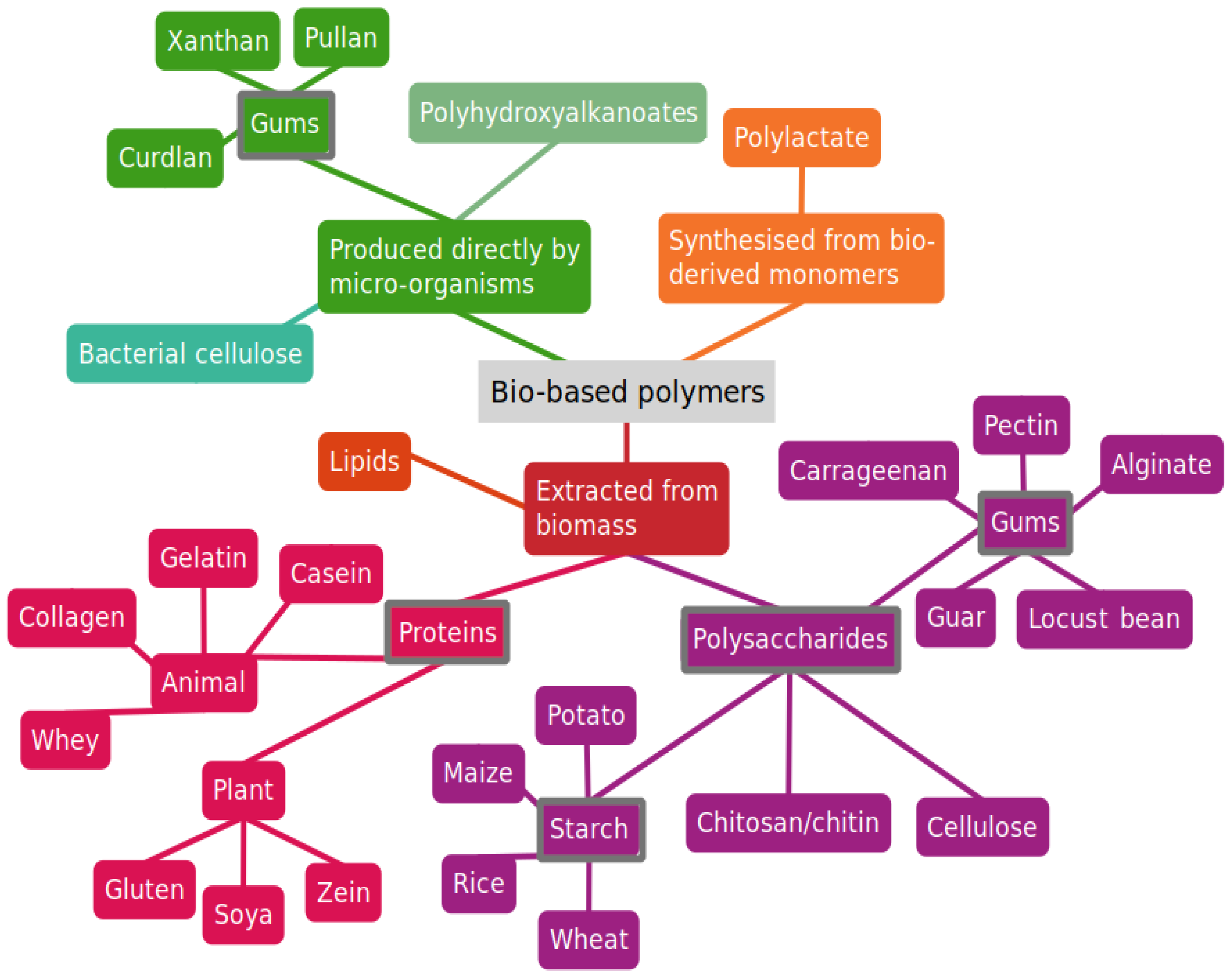
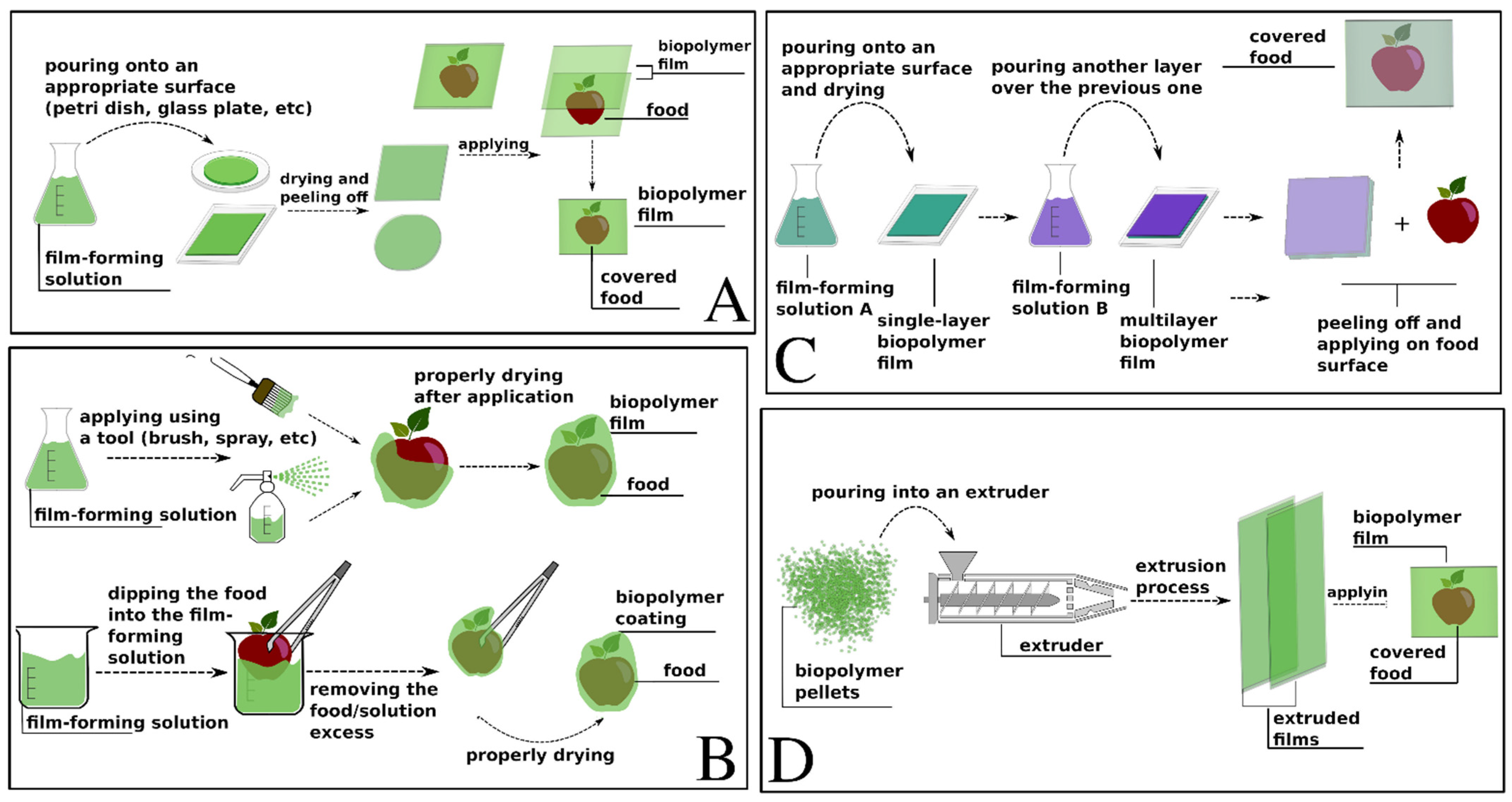
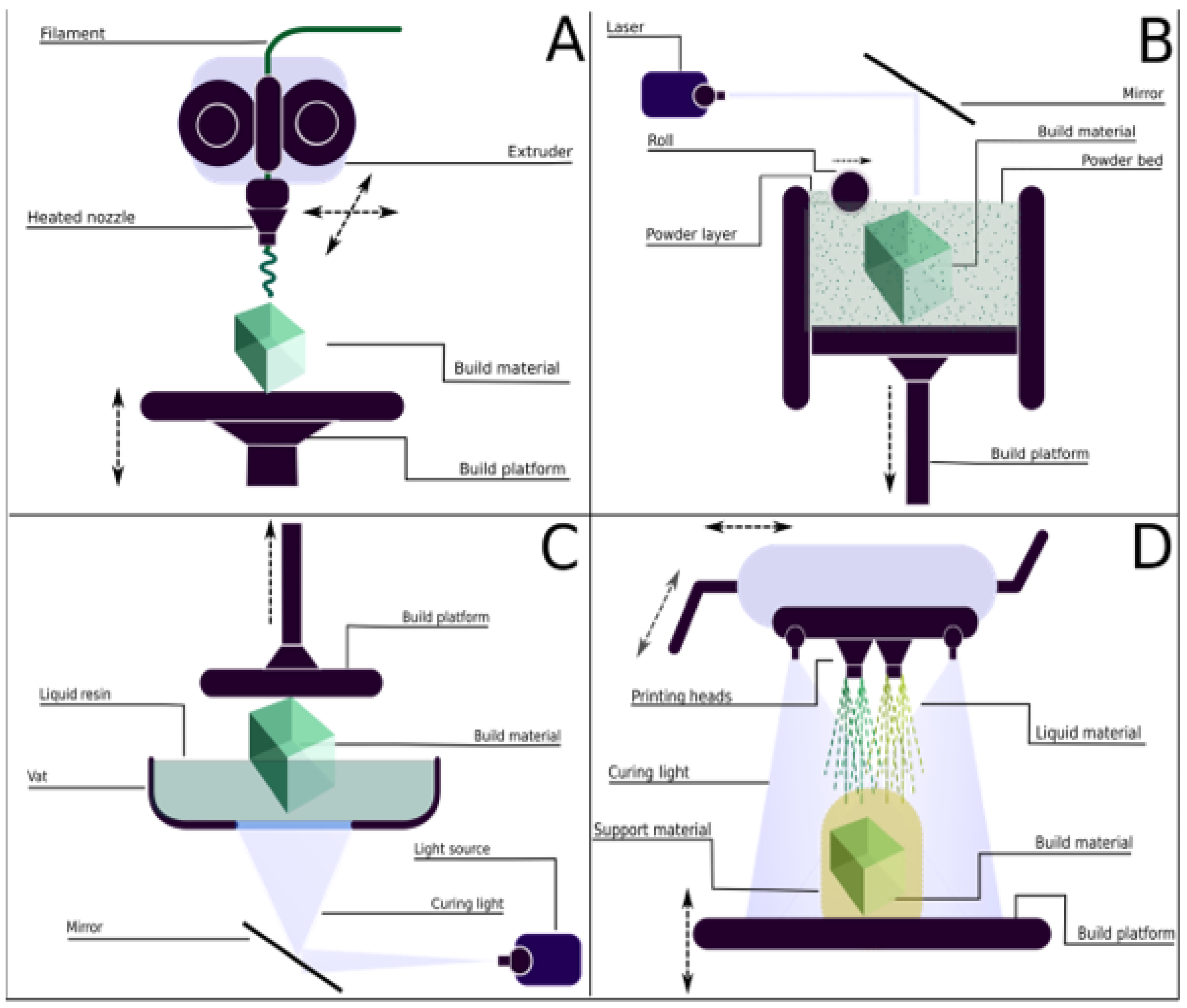
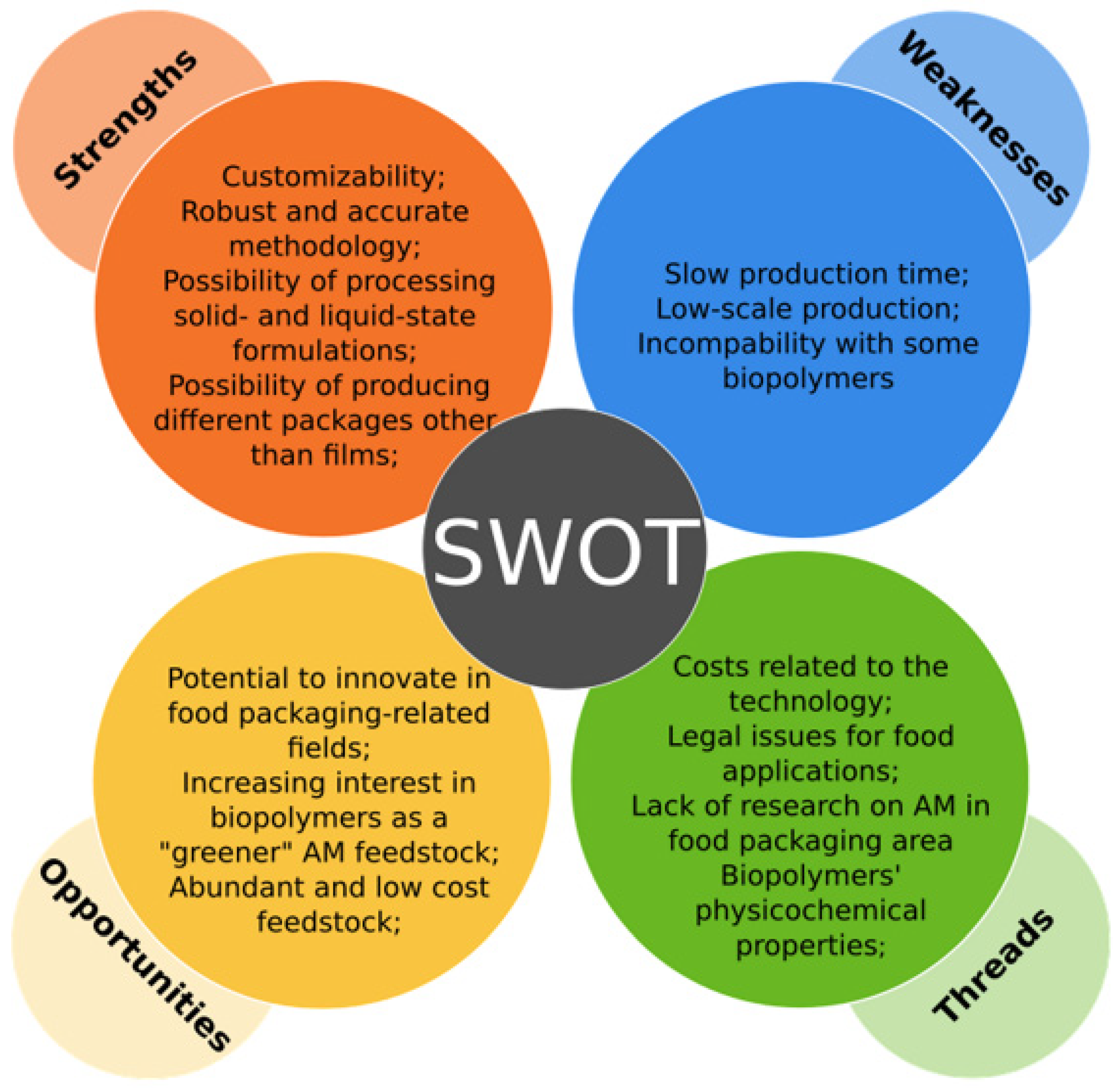
| Method | Main Characteristics |
|---|---|
| Solution casting | The film-forming solution is cast on a surface (e.g., a Petri dish), appropriately dried, and the formed film is peeled off; It is the simplest method for film preparation; The conditions used are relatively mild; It is time-consuming; It is limited to lab scale; |
| Coating | The film-forming solution is directly applied onto the food by means of dipping, spraying, or brushing and dried afterwards in appropriate conditions; Often applied on fresh food; Materials must be of food grade if the coating is meant to be eaten; Some applications in the food industry (mostly wax coatings); |
| Layer-by-layer assembly | Based on the deposition of alternating layers; Deposition can be achieved either by submersion in or spraying the film-forming solutions on the food; Potential for industrial applications, though currently it is mostly limited to lab scale; |
| Extrusion | The mixture containing the biopolymer is poured into an extruder system, which produces a uniform film at the end of the process; Faster and less energy-demanding than the solution casting method; Produces films with superior mechanical and thermal properties; Conditions may be aggressive for biopolymers; Can be scaled up for industrial settings; |
| Methodology | Aim | Used Biopolymers | Other Components | Properties | Ref. |
|---|---|---|---|---|---|
| Casting | Effect of chitosan molecular weight on film performance | Chitosan | - | Improved preservation abilities; Improved performance with high chitosan weights/contents | [29] |
| Influence of chitosan molecular weight on the film properties | Chitosan + bacterial cellulose | Curcumin | Improved performance with high chitosan weights/contents | [30] | |
| Develop a multifunctional food packaging film | Chitosan | Alizarin | pH-responsive film (4–10 range); Improved thermal stability, hydrophobicity, and UV-blocking properties | [31] | |
| Effect of a starch source on the performance of edible starch-based films | Starch (tapioca, rice, potato, and wheat) | - | Tapioca, potato, and rice starch had better mechanical strength and less color difference | [32] | |
| Production of biodegradable cellulose/alginate films | Cellulose, alginate, and carrageenan | - | Films showed weight loss of up to 50% after 60 days buried in soil; Activity against E. coli, Pseudomonas syringae, and S. aureus strains | [33] | |
| Develop UV absorbent films | Polylactic acid | Grape syrup | High UV absorption property | [34] | |
| Develop functional bio-hydrogel films for food packaging | Alginate, agar, and collagen | Grapefruit seed extract Silver NPs | Improved mechanical properties; High UV screening; Strong antimicrobial activity: prevents greening of fresh potatoes | [35] | |
| Study the influence of nano-SiO2 concentration on the properties of the films | Agar + alginate | Silicon oxide NPs | Improved mechanical properties | [36] | |
| Evaluated the effect of fatty acid chain length on the properties of edible films | Basil seed gum-based | Caprylic, lauric, and palmitic acids | Improved barrier properties; Improved mechanical properties (lauric and caprylic acids) | [37] | |
| Develop intelligent films for food packaging | Gellan gum and soy protein | Clitoria ternatea extract | pH-responsive (3–11 range); Bacteriostatic activity | [38] | |
| Evaluate the influence of the concentration of the extract on the properties of films | Starch | Red cabbage extract | Antioxidant activity; Significantly increased food shelf life (meat) | [17] | |
| Develop a composite film and evaluate its activity as primary food packaging for fresh poultry | Chitosan | Rosemary essential oil and montmo-rillonite | Antioxidant and antimicrobial activity; Improved barrier properties; Films were able to retard lipid peroxidation (poultry) | [19] | |
| Develop a film with mesoporous silica NPs loaded with clove essential oil | Polylactic acid | Clove essential oil and silica NPs | Antimicrobial activity; Controlled the release of the active compound | [16] | |
| Coating and solvent casting | Develop a film-forming formulation and compare the effects of different applications (coating, wrapping, and direct application of active compounds) on food | Alginate and cellulose | Ziziphora essential oil, apple peel extract, and zinc oxide nanoparticles | Coating showed the lowest bacterial population and best sensory attributes among the studied methodologies | [39] |
| Investigate the potential of cranberry extract as an antibiofilm additive for a chitosan-based film | Chitosan | Cranberry extract | Antioxidant and antimicrobial activities | [18] | |
| Coating | Develop a superhydrophobic food-grade coating | - | Candelilla and rice bran waxes | Highly hydrophobic coating; Excellent coating resistance to physical damage | [40] |
| LBL and coating | Compare the effects of coatings by means of LBL and standard coating | Chitosan; Cellulose | - | Single-layer and LBL coatings had positive effects on strawberry conservation; LBL coating showed better performance at reducing firmness and volatile compound loss | [41] |
| LBL | Development of a bilayered chitosan/FucoPo film | Chitosan and FucoPol | - | Improved gas barrier towards O2 and CO2 in comparison with monolayer film | [42] |
| Prepare and characterize an antibacterial film | Chitosan and modified polyethylene | Hyaluronic acid | Excellent antibacterial activity; Improved degradability | [43] | |
| LBL and solution casting | Evaluate the effects of preparation methods on the properties of the films | Chitosan and alginate | Ferulic acid | Crosslinked LBL films showed better results with improved mechanical, thermal, optical, and barrier properties | [44] |
| Extrusion | Study the effect of nanofillers on extruded films | Chitosan and starch | Nanoclay and bamboo fibers | Improved mechanical, thermal, and barrier properties | [45] |
| Investigate the effects of nanoclay contents and pH levels on the properties of the films | Soy protein | Nanoclay | Nanoclay addition improved mechanical and rheological properties; pH changes demonstrated to have positive effects on film properties | [46] | |
| Evaluated the potential of the extrusion process and wax source on edible film properties | Rennet casein | Potassium sorbate; bee, candelilla, and carnauba waxes; | Beeswax had the best performance in terms of improving mechanical properties and hydrophobicity; Wax incorporation allowed a controlled release of potassium sorbate | [47] | |
| Develop a composite film and evaluate its activity as primary food packaging for fresh minced meat | Starch | Sappan and cinnamon herbal extracts | Improved barrier properties; Reduced microbial counts; Preservation of redness of packaged meat | [15] |
| AM Technology | Polymer/Active Compounds and Fillers | Proposed Application | Properties | Ref. |
|---|---|---|---|---|
| Vat photo-polymeriza -tion | Guaiacol, vanillyl alcohol, and eugenol (acrylates) | Sustainable 3D-printing feedstock formulation | Good thermal and mechanical properties | [55] |
| Silk fibroin (acrylate) | 3D bioprinting in tissue engineering applications | Improved mechanical properties | [56] | |
| Powder bed fusion | Polylactide | Sustainable 3D-printing feedstock formulation | Good layer adhesion and good mechanical properties | [57] |
| Polylactic acid/calcium carbonate | Tissue engineering | Good processability, mechanical properties, low melt viscosity, and small particle size | [58] | |
| Hard keratin | Sustainable 3D-printing feedstock formulation | Weaker mechanical properties; Successful keratin incorporation/proce- ssing | [71] | |
| Polyhydroxyalkanoate/akermanite | Tissue engineering | Improved water-uptake properties | [59] | |
| Material extrusion | Lignin and polylactic acid | Wound healing | Good mechanical properties and stability; Successful incorporation of an antibiotic | [61] |
| Polylactic acid and starch/coconut shell | Sustainable 3D-printing feedstock formulation | Improved thermal and mechanical properties | [62] | |
| Chitosan/genipin | Wound healing | Good release rate of the active compound | [63] | |
| Chitosan and starch/lemongrass essential oil and mulberry anthocyanin | Food packaging | Color-changing properties; Antibacterial effect | [64] | |
| Chitosan/tea polyphenols and halloysite nanotubes | Food packaging | Good antioxidant and antibacterial activity; Improved mechanical properties | [65] | |
| Bio-based plastic “Ecoflex”/silica–carbon–silver nanoparticles | Food packaging | Bacteriostatic effect | [67] | |
| Gelatin/zinc oxide and clove essential oil | Food packaging | Improved mechanical properties and antibacterial activity | [68] | |
| Chitosan and cellulose/blueberry anthocyanin and methylcyclopropene | Food packaging | Color changing properties and preservation ability | [69] | |
| Polylactic acid (virgin and recycled) | Sustainable 3D-printing feedstock formulation | Improved both mechanical and thermal properties | [70] |
Disclaimer/Publisher’s Note: The statements, opinions and data contained in all publications are solely those of the individual author(s) and contributor(s) and not of MDPI and/or the editor(s). MDPI and/or the editor(s) disclaim responsibility for any injury to people or property resulting from any ideas, methods, instructions or products referred to in the content. |
© 2022 by the authors. Licensee MDPI, Basel, Switzerland. This article is an open access article distributed under the terms and conditions of the Creative Commons Attribution (CC BY) license (https://creativecommons.org/licenses/by/4.0/).
Share and Cite
Silva, E.G.S.; Cardoso, S.; Bettencourt, A.F.; Ribeiro, I.A.C. Latest Trends in Sustainable Polymeric Food Packaging Films. Foods 2023, 12, 168. https://doi.org/10.3390/foods12010168
Silva EGS, Cardoso S, Bettencourt AF, Ribeiro IAC. Latest Trends in Sustainable Polymeric Food Packaging Films. Foods. 2023; 12(1):168. https://doi.org/10.3390/foods12010168
Chicago/Turabian StyleSilva, Edilson G. S., Sara Cardoso, Ana F. Bettencourt, and Isabel A. C. Ribeiro. 2023. "Latest Trends in Sustainable Polymeric Food Packaging Films" Foods 12, no. 1: 168. https://doi.org/10.3390/foods12010168
APA StyleSilva, E. G. S., Cardoso, S., Bettencourt, A. F., & Ribeiro, I. A. C. (2023). Latest Trends in Sustainable Polymeric Food Packaging Films. Foods, 12(1), 168. https://doi.org/10.3390/foods12010168








